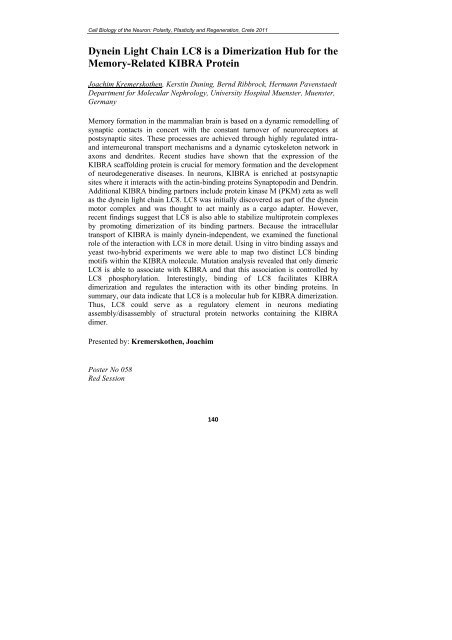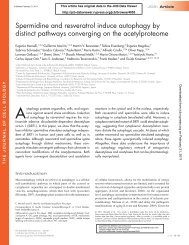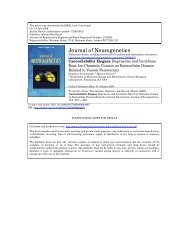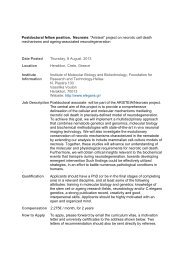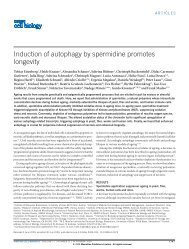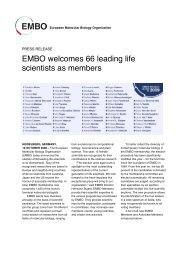CELL BIOLOGY OF THE NEURON Polarity ... - Tavernarakis Lab
CELL BIOLOGY OF THE NEURON Polarity ... - Tavernarakis Lab
CELL BIOLOGY OF THE NEURON Polarity ... - Tavernarakis Lab
You also want an ePaper? Increase the reach of your titles
YUMPU automatically turns print PDFs into web optimized ePapers that Google loves.
Cell Biology of the Neuron: <strong>Polarity</strong>, Plasticity and Regeneration, Crete 2011<br />
Dynein Light Chain LC8 is a Dimerization Hub for the<br />
Memory-Related KIBRA Protein<br />
Joachim Kremerskothen, Kerstin Duning, Bernd Ribbrock, Hermann Pavenstaedt<br />
Department for Molecular Nephrology, University Hospital Muenster, Muenster,<br />
Germany<br />
Memory formation in the mammalian brain is based on a dynamic remodelling of<br />
synaptic contacts in concert with the constant turnover of neuroreceptors at<br />
postsynaptic sites. These processes are achieved through highly regulated intra-<br />
and interneuronal transport mechanisms and a dynamic cytoskeleton network in<br />
axons and dendrites. Recent studies have shown that the expression of the<br />
KIBRA scaffolding protein is crucial for memory formation and the development<br />
of neurodegenerative diseases. In neurons, KIBRA is enriched at postsynaptic<br />
sites where it interacts with the actin-binding proteins Synaptopodin and Dendrin.<br />
Additional KIBRA binding partners include protein kinase M (PKM) zeta as well<br />
as the dynein light chain LC8. LC8 was initially discovered as part of the dynein<br />
motor complex and was thought to act mainly as a cargo adapter. However,<br />
recent findings suggest that LC8 is also able to stabilize multiprotein complexes<br />
by promoting dimerization of its binding partners. Because the intracellular<br />
transport of KIBRA is mainly dynein-independent, we examined the functional<br />
role of the interaction with LC8 in more detail. Using in vitro binding assays and<br />
yeast two-hybrid experiments we were able to map two distinct LC8 binding<br />
motifs within the KIBRA molecule. Mutation analysis revealed that only dimeric<br />
LC8 is able to associate with KIBRA and that this association is controlled by<br />
LC8 phosphorylation. Interestingly, binding of LC8 facilitates KIBRA<br />
dimerization and regulates the interaction with its other binding proteins. In<br />
summary, our data indicate that LC8 is a molecular hub for KIBRA dimerization.<br />
Thus, LC8 could serve as a regulatory element in neurons mediating<br />
assembly/disassembly of structural protein networks containing the KIBRA<br />
dimer.<br />
Presented by: Kremerskothen, Joachim<br />
Poster No 058<br />
Red Session<br />
140


